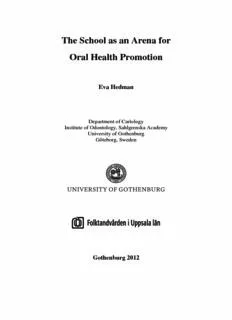
The School as an Arena for Oral Health Promotion PDF
Preview The School as an Arena for Oral Health Promotion
The School as an Arena for Oral Health Promotion Eva Hedman Department of Cariology Institute of Odontology, Sahlgrenska Academy University of Gothenburg Göteborg, Sweden Gothenburg 2012 2 Abstract The School as an Arena for Oral Health Promotion Eva Hedman, Department of Cariology, Institute of Odontology, Sahlgrenska Academy, University of Gothenburg, Box 450, SE-405 30 Göteborg, Sweden. Objective: This thesis focuses on the school as an “arena for oral health promotion”. The overall aim was to describe adolescents’ and dental professionals’ knowledge of and attitudes to oral health and oral health promotion. In addition, the aim was to implement an intervention programme in Swedish secondary schools. Design: Both quantitative (Papers I and III) and qualitative research methods (Papers II and IV) were used. Paper I was a baseline survey, based on a questionnaire distributed in schools about knowledge of and attitudes towards oral health among adolescents in grades 6 and 9 (n=793). Paper II was performed as an individual interview study carried out by nine dental hygienists and nurses. The interviews were analysed in accordance with the principles of the discourse method. In Paper III, an experimental longitudinal intervention study based on 534 adolescents in grades 6-9 was evaluated. The intervention group was given education for two years and offered preventive measures, such as fluoride varnish treatment every six months, while the control group received no intervention. A questionnaire about knowledge of and attitudes towards oral health and tobacco was used and caries incidence and progression were assessed on bite-wing radiographs. Paper IV was an interview study based on three focus groups with adolescents from the intervention study. The interviews were analysed according to a phenomenographic approach. Results: The results of the questionnaires used in Papers I and III showed that the adolescents regarded their oral health as important. Their knowledge of oral hygiene was good, but when they were asked to explain terms relating to oral diseases was limited. Girls had more knowledge than boys, 15- year–olds more than 12-year-olds while natives of Sweden had more knowledge than those with an immigrant background (Paper I). Dental hygienists and nurses in Paper II expressed a desire to work with health promotion, although their approach differed, as some asked for interaction with adolescents, while others preferred more traditional methods based on one-way communication. When it came to caries development after the two-year oral health intervention, fewer individuals had developed enamel caries compared with the control group (p=0.002), but no differences concerning dentine caries could be found. The preventive fraction was estimated to be 50% (Paper III). In Paper IV, the adolescents stated that the oral health programme had given them a feeling of control over their own oral health. The fluoride varnish treatment performed in groups was experienced differently by the adolescents. For some adolescents, the group treatment appeared a feeling of security, while others expressed a sense of vulnerability. Conclusion: These series of studies demonstrate that oral health promotion carried out in secondary schools is an interesting approach when it comes to preventing enamel caries and to providing an insight into adolescents’ and dental staffs’ attitudes to both oral and general health, including smoking habits. Key words: Adolescents, Dental caries, Oral health promotion, Prevention, Secondary school Sweden. ISBN 978-91-628-8541-0 e-publish http:// hdl.handle.net/2077/30261 [email protected] 3 4 Contents Original papers...........................................................................................7 Abbreviations and definitions....................................................................9 Introduction..............................................................................................11 General aim..............................................................................................25 Methods....................................................................................................27 Results......................................................................................................35 Discussion................................................................................................41 Conclusions..............................................................................................49 Acknowledgements..................................................................................51 References................................................................................................53 Paper I-IV Appendix 1-3 5 6 Original papers This thesis is based on the following four papers, which will be referred to in the text by their Roman numerals (I-IV): I. Hedman E, Ringberg K, Gabre P. Knowledge of and attitude to oral health and oral diseases among young adolescents in Sweden. Swed Dent J, 30:147-154, 2006. II. Hedman E, Ringberg K, Gabre P. Oral health education for schoolchildren: a qualitative study of dental care professionals’ view of knowledge and learning. Int J Dent Hygien, 7:204-211, 2009. III. Hedman E, Gabre P, Birkhed D. Dental hygienists working in schools - a two-year oral health intervention program in Swedish secondary schools. Submitted for publication. IV. Hedman E, Gabre P, Birkhed D, Lepp M. Adolescents’ experiences of a two-year oral health intervention program in Swedish secondary schools. Submitted for publication. Publications I and II are reprinted with kind permission of the publisher 7 8 Abbreviations and definitions The following terminology is used in this thesis: Caries incidence = Caries free surfaces that turn into enamel lesions, dentin lesions or fillings in a specific time Caries progression = Enamel lesions that proceed to dentin lesions or fillings in a specific time. D Sa = Approximal caries lesion in the outer half of the enamel (level 1) 1 D Sa = Approximal caries lesion more than halfway through the enamel but not passing the 2 enamel-dentine junction (level 2) D Sa = Approximal caries lesions extending into dentine (level 3) 3 D + + FSa = Approximal enamel and dentine caries lesion on level 1+2 +3 and fillings 1 2 3 D FSa = Approximal dentine caries lesions and fillings 3 . 9 10
Description: